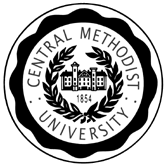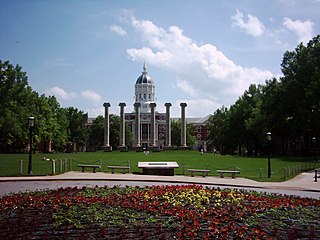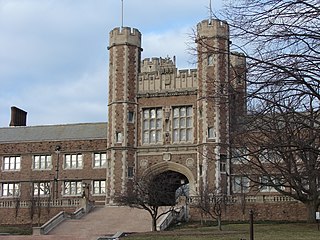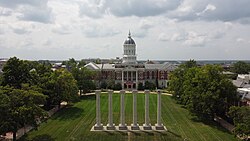
The Rotunda is a building located on The Lawn on the original grounds of the University of Virginia. Thomas Jefferson designed it to represent the "authority of nature and power of reason" and modeled it after the Pantheon in Rome. Construction began in 1822 and was completed shortly after Jefferson's death in 1826. The campus of the new university was unique in that its buildings surrounded a library rather than a church, as was common at other universities in the English-speaking world. To many, the Rotunda symbolizes Jefferson's belief in the separation of church and education, and represents his lifelong dedication to education and architecture. The Rotunda was designated a National Historic Landmark in 1966, and is part of the University of Virginia Historic District, designated in 1971.
The Mizzou Botanic Garden contains thousands of plants within the campus of the University of Missouri in Columbia, Missouri, United States. The Garden includes famous icons, such as Thomas Jefferson's original grave marker and the Columns of Academic Hall, and is open year-round, only asking for a small donation to visit.

Franklin College is a private liberal arts college in Franklin, Indiana. It was founded in 1834 and has a wooded campus spanning 207 acres (84 ha) including athletic fields and a 31-acre (13 ha) biology woodland. The college offers its approximately 1,000 students Bachelor of Arts degrees in 49 majors from 25 academic disciplines, 43 minors, 11 pre-professional programs, and 5 cooperative programs. The college also offers a Master of Science in Athletic Training and a Master of Science in Physician Assistant Studies. In 1842, the college began admitting women, becoming the first coeducational institution in Indiana and the seventh in the nation. Franklin College has historically maintained an affiliation with the American Baptist Churches USA.

Central Methodist University is a private university in Fayette, Missouri. CMU is accredited to offer master's, bachelors, and associate degrees. The school is affiliated with the United Methodist Church.

The Missouri State Capitol is the home of the Missouri General Assembly and the executive branch of government of the U.S. state of Missouri. Located in Jefferson City at 201 West Capitol Avenue, it is the third capitol to be built in the city. The domed building, designed by the New York City architectural firm of Tracy and Swartwout, was completed in 1917.

QEBH is a senior honor society at the University of Missouri. Founded in 1898, it is the oldest of six recognized secret honor societies that participate in the annual tradition of Tap Day on campus. The meaning of the society's name is known only to the members.

Jesse Hall, formerly New Academic Hall, is the main administration building for the University of Missouri. Its dome has towered 180 feet (55 m) above the south end of David R. Francis Quadrangle since its completion in 1895. In the lawn in front of Jesse Hall are The Columns, all that remains of its predecessor Academic Hall, which was destroyed by fire in 1892. The building contains the office of the chancellor, university registrar, graduate school, admissions, and financial aid. One of the most photographic landmarks in Missouri, the building was designed by Missouri architect Morris Frederick Bell, and is his largest surviving work. Jesse Auditorium had hosted graduations and many university functions over the years. The University Concert Series presents national and international concerts, Broadway shows, performers, bands, speakers, and theater to the largest auditorium in Columbia. As the former home of the School of Music, student performances occasionally take place. The building is the most prominent contributing structure to the David R. Francis Quadrangle National Register of Historic Places District. In 1922, "New Academic Hall" was renamed "Jesse Hall" in honor of retiring University President Richard Henry Jesse.

The University of Missouri in Columbia, Missouri, was established in 1839. This later expanded to the statewide University of Missouri System.

In architecture, a quadrangle is a space or a courtyard, usually rectangular in plan, the sides of which are entirely or mainly occupied by parts of a large building. The word is probably most closely associated with college or university campus architecture, but quadrangles are also found in other buildings such as palaces. Most quadrangles are open-air, though a few have been roofed over, to provide additional space for social meeting areas or coffee shops for students.
Switzler Hall is an academic hall on the campus of the University of Missouri in Columbia, Missouri. The building was completed in 1872, and it is located on the west side of the David R. Francis Quadrangle. Switzler Hall is the oldest academic building and second oldest structure on campus after the Chancellor's Residence. The building was named after Colonel William Franklin Switzler, editor and publisher of the Missouri Statesman and supporter of the University. Today the building houses the Department of Communication, Women's and Gender Studies, and the Special Degrees Program. The building is listed on the National Register of Historic Places.
Richard Henry Jesse was an American educator and the eighth president of the University of Missouri in Columbia, Missouri. He was born in Lancaster County, Virginia 1853 and attended the University of Virginia. He went on to teach at the University of Louisiana and Tulane University before assuming the presidency 1891. He retired in 1908. Jesse Hall on the David R. Francis Quadrangle is named in honor of him and was initiated as an Honorary member of the Acacia Fraternity. He is buried in Columbia at the Columbia Cemetery.

Academic Hall was the original main building of the University of Missouri. It was dedicated in 1843 and destroyed by fire in 1892. Academic Hall's six Ionic columns, today known as The Columns, stand on Francis Quadrangle as the most recognizable symbol of the University of Missouri.

The Washington University Hilltop Campus Historic District was the site of the 1904 Louisiana Purchase Exposition and the 1904 Summer Olympics. Many of the exposition buildings were temporary in nature, but a number of permanent structures were built and are used by Washington University, which calls this area the Danforth Campus. The district includes more than fifty structures, of which twenty are in the Collegiate Gothic style.

Downtown Columbia is the central business, government, and social core of Columbia, Missouri and the Columbia Metropolitan Area. Three colleges — the University of Missouri, Stephens College, and Columbia College — all border the area. Downtown Columbia is an area of approximately one square mile surrounded by the University of Missouri on the south, Stephens College to the east, and Columbia College on the north. The area serves as Columbia's financial and business district and is the topic of a large initiative to draw tourism, which includes plans to capitalize on the area's historic architecture and Bohemian characteristics. The downtown skyline is relatively low and is dominated by the 10-story Tiger Hotel, built in 1928, and the 15-story Paquin Tower.

The University of Missouri is a public land-grant research university in Columbia, Missouri. It is Missouri's largest university and the flagship of the four-campus University of Missouri System. MU was founded in 1839 as the first public university west of the Mississippi River. It has been a member of the Association of American Universities since 1908 and is classified among "R1: Doctoral Universities – Very high research activity."
Stephen Hills was an architect notable for designing the original Pennsylvania State Capitol.

The Quad is an approximately 22-acre (8.9 ha) quadrangle on the campus of the University of Alabama located in Tuscaloosa, Alabama. Home to most of the university's original buildings, this portion of the campus remains the geographic and historic center of the modern campus. Originally designed by architect William Nichols, construction of the university campus began in 1828, following the move of the Alabama state capital from Cahaba to Tuscaloosa in 1826. The overall design for this early version of the campus was patterned after Thomas Jefferson's plan for the University of Virginia, with its Lawn and Rotunda. Following the destruction of the campus during the American Civil War, a new Quad emerged in the late 19th and early 20th centuries. Different in form and function from the original design of the early 19th century, the modern Quad continues to fill its role as the heart of the campus. Although surrounded by academic and administrative buildings, only five structures are built directly on the Quad: the Little Round House, Tuomey Hall, Oliver-Barnard Hall, Amelia Gayle Gorgas Library, and Denny Chimes. The remainder of the space is occupied by a grove of trees on the west side and a great lawn on the east. A feature on the northwestern side, known as The Mound, is the site of the old Franklin Hall. A popular gathering place, the Quad is home to pep rallies, a bonfire during homecoming, and numerous day-to-day student activities.
Morris Frederick Bell was an American architect known primarily for his institutional buildings but also for his domestic and commercial structures. His best known work is the David R. Francis Quadrangle the historic center of the University of Missouri including Jesse Hall. He also designed state correctional schools in Boonville, Chillicothe, and Tipton; and state mental hospitals in Fulton, Higginsville, and Nevada. Bell, a democrat, was also active in civic life, especially Masonic organizations. He trained and employed William Lincoln Garver as an assistant. Garver would later go on to have a stand-alone career.
8th Street, more commonly known as the Avenue of the Columns, is an urban street in downtown Columbia, Missouri. It connects the University of Missouri and Francis Quadrangle to the Boone County Court House and the Columbia City Hall. The avenue has long symbolized "town and gown" in this Midwestern college town. Sitting in the center of Francis Quad on the south are the 6 ionic columns of the former Academic Hall, aligned with these on the north are the 4 doric columns of the former Boone County Courthouse. William Jewell, the first mayor of Columbia, is said to be responsible for this decision. The domed Jesse Hall and its corinthian columns are also in the alignment. The street is also home to the Tiger Hotel, the Guitar Building, and the offices of the Columbia Missourian. Civic planning efforts have focused on in-fill development and beautification. In 2014, it became the center of a controversy over the decision to build single-use student housing despite mixed-use and ground floor retail being the focus of community planning. In 5 blocks, the street crosses two National Register of Historic Places districts.

The Columns are the most recognizable landmark of the University of Missouri in Columbia, Missouri. Standing 43 feet (13 m) tall in the center of Francis Quadrangle and at the south end of the Avenue of the Columns, they are the remains of the portico of Academic Hall. Along with Jesse Hall, they are one of the most photographed sites in Missouri. The Columns have been at the center of many traditions and events including graduations, concerts, pranks, weddings, and protests. Mizzou's school song mentions the columns, and they have been the setting for a work of fiction. They are a contributing structure to the Francis Quadrangle National Historic District. The columns underwent preservation work in 2017.


















































